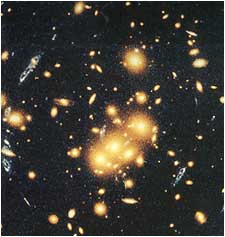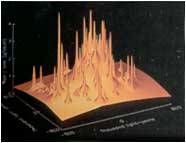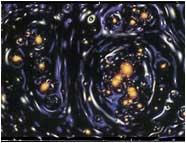Visualizing the Invisible
Stars and galaxies make up less than 10 percent of the matter in our universe; mysterious "dark matter" makes up the rest. It cocoons every galaxy, including our Milky Way. Its immense gravitational pull also controls the growth and evolution of giant groups of galaxies.
Although astronomers cannot detect the dark matter with telescopes, they can infer its distribution through gravitational lens mass tomography, a technique that relies upon the bending of light by strong concentrations of mass.

The gravitational lensing of an extremely distant blue galaxy by the foreground galaxy cluster CL0024+1654, itself 2 billion light years from Earth, results in multiple images (right). Powerful gravitational fields within the cluster force the distant galaxy's light to travel along many different paths on its way to Earth, creating the smears of blue light in this Hubble Space Telescope image.
|  Computer simulations allowed astronomers to retrace the paths that rays of light follow through CL0024+1654, just as tomographic scans reveal the patterns of bone and tissue within a human body. The simulations reveal that only a particular distribution of dark matter within the cluster would create the exact blue patches of light in the Hubble image. The orange peaks represent the most intense concentrations of dark matter in the cluster. Astronomers tested more than one million possible distributions of dark matter to derive this solution. |  Astronomers run simulations to test whether dark matter actually resides in tight clumps around individual galaxies. A lumpy distribution of dark matter would create wildly distorted images, in which the blue light from the distant galaxy bends into surreal swirls and loops rather than the smears we see in the Hubble image. Because no such patterns are seen in space, astronomers conclude that most dark matter spreads out fairly evenly within giant clusters and superclusters of galaxies. |
We can thank this mysterious matter for some of nature's most beautiful displays. The collective gravity of an entire cluster can act as a powerful gravitational lens. It warps the light from more distant galaxies into ethereal arcs. Individual galaxies in the cluster also form smaller lenses, so the paths followed by light through these clusters can become quite complex. These cosmic mirages often magnify extremely remote galaxies that we would otherwise miss with our telescopes. In this way, massive gravitational lenses serve as peepholes to the distant universe.
Simulations of the cosmos with powerful supercomputers also point to dark matter's supremacy. Computers now perform so many calculations per second that astrophysicists can explore how the structure of the universe has evolved. Billions of years in the cosmos are compressed to weeks or months of computer time. Many thousands of virtual particles, representing galaxies, drift within a cube that mimics a chunk of the universe measuring hundreds of millions of light-years on a side. The programs simulate the slow but relentless effects of gravity. The attraction draws galaxies together into clumps and weblike filaments, leaving behind gaping voids. But it is the added pull of dark matter that makes these computerized patterns of galaxies resemble the patterns we see in space. Without dark matter, galaxies in the simulations simply fly apart from one another because of their own random motions.
If we have convinced you by now that dark matter exists, you probably are wondering what it is. Join the club. It's the astrophysical mystery of the century--both the twentieth century and, perhaps, the twenty-first. One researcher compared studying dark matter to assembling the pieces of an all-black puzzle in a black room. With thick black gloves on, we might add. Not only can't we see dark matter, but there doesn't seem much hope of putting our hands on it.
This is not to say that progress is impossible. The search for dark matter is happening on many fronts. For a time it seemed that much of the missing matter might be ordinary stuff like stars and planets, but too far away or too dim for us to see. We know that stars below a certain size glow faintly or fail to ignite nuclear fusion in their cores at all. We call such objects brown dwarfs. Jupiter-sized planets could wander the galaxy as well, unaffiliated with any star. Astronomers who envisioned a cloud of these things around the Milky Way dubbed them MACHOs, an aggressive acronym for "massive compact halo objects." How might we detect these ghosts? It turns out that a (continued) |

